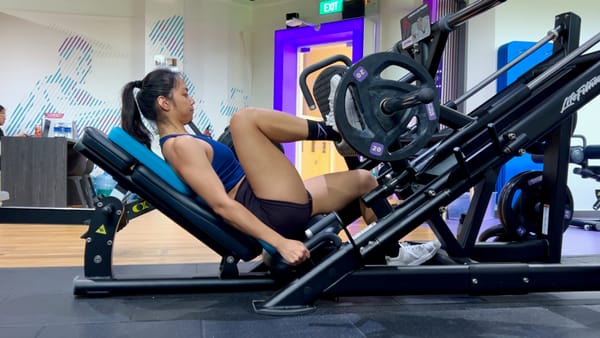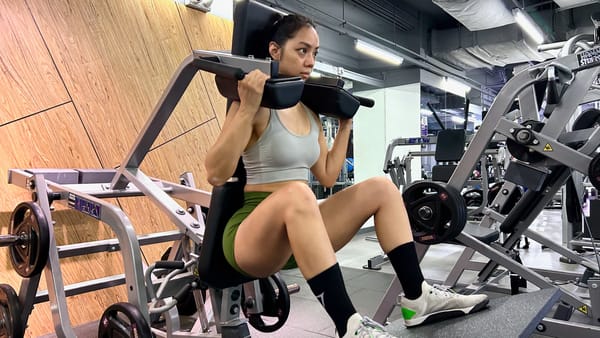Smith Machine Squat vs Barbell Squat: How to Choose?
Popular comparison: Smith machine squat vs barbell squat. Learn how they’re different, what’s similar, and how to choose your squat variation.
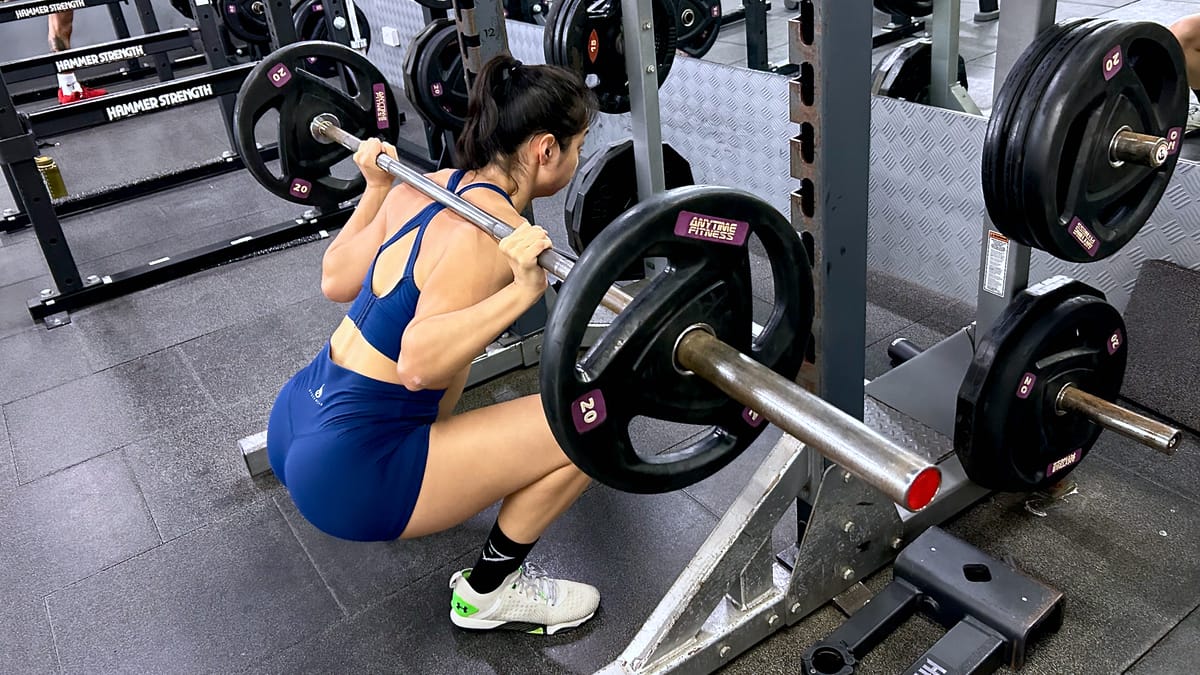
You know squats are a staple in any workout. But which is really better — the Smith machine squat or the barbell squat?
Let’s start by being candid: you can’t go wrong with either type of squat.
Both Smith machine squats and barbell squats are fantastic options for training your quads and glutes. (Btw, squats aren’t great for training hamstrings!)
But there are some differences that might make one of them a better fit for you.
Find out what these differences are and how you can pick your favorite squat variation!
Smith machine squat vs barbell squat
To be sure we’re on the same page, this is what each of these exercises looks like.
Smith machine squat:

Barbell squat:
Now, let’s look at some of the ways we can compare both types of squats.
Comparison of Smith machine squats and barbell squats
| Comparison | Answer | Reason |
|---|---|---|
| Which is harder to master? | Barbell squat | More demanding on technique, mobility, and balance |
| Which has a more transferrable technique? | Barbell squat | Technique on barbell squats is more easily applied to squat-like exercises |
| Which is easier to set up? | Similar | Both require loading of weight plates which takes the most time |
| Which has a more stable setup? | Smith machine squat | Fixed bar path allows for more stability |
| Which can you use more weight on? | Smith machine squat | Don't need to worry about stabilizers or balance |
| Which is generally safer? | Smith machine squat | Easier to rack during failure or bail when necessary |
| Which is more available in the gym? | Smith machine squat | Smith machines are way less popular than squat racks |
What's similar between Smith machine squats and barbell squats?
As you’d reasonably expect, both Smith machine squats and barbell squats have plenty in common.
That’s why switching between both variations is pretty straightforward.
Let’s start by looking at some key similarities between these 2 types of squats.
Similarities in setup
Before starting your squats:
- Set the bar at chest height: This is the ideal height from which you can safely unrack and rack your bar.
- Pull the bar into your traps: Creates tension in your torso and prevents the bar from moving about and affecting your stability.
- Brace your core: Provides a strong and stable midsection for efficiency and safety. Think about “preparing yourself for a punch”.
Similarities in cues
During your squats:
- Distribute your weight evenly across each foot: Maintain a “tripod foot” position to maximize your efficiency and stability.
- Push your knees out slightly: Engages your hip stabilizers (glute muscles) for a strong knee position and prevents knees from caving inwards during the squat.
- Drive upwards with your quads in the bottom position: Ensures that your hips and torso move up together as 1 unit. Prevents your hips from rising up first.
Here’s a squat checklist to help you along:
What are the cues that only apply to barbell squats?
Position your feet directly under the bar
For a barbell squat, keep your feet directly under the bar.
This setup ensures that you move in a straight path and stay balanced throughout, which is incredibly important for a free-weight squat.
TBH, there’s really no other way to position your feet for a barbell back squat.
Keep the center of gravity over your midfoot
Imagine how you’d look from the side during a squat.
Draw a line from your bar straight down to the ground. This line should run through your midfoot.
This distributes the weight evenly across your feet and helps you move through the squat more efficiently. The better you are at this, the more weight you can likely move.
Lean forward naturally
The forward lean in barbell squat happens naturally to allow you to squat downwards without losing balance.
You don’t want to exaggerate your lean since this shifts the weight forward and leaves you off-balance.
As for how much forward lean you need? This depends on your anatomy, technique, and mobility. Take your body’s cues on this (and probably a video of your form). You need just enough forward lean to keep the bar moving up and down in a straight path.
What are the cues that only apply to Smith machine squats?
Position your feet slightly in front of the bar
For the Smith machine squat, you want to keep your feet slightly in front of the bar.
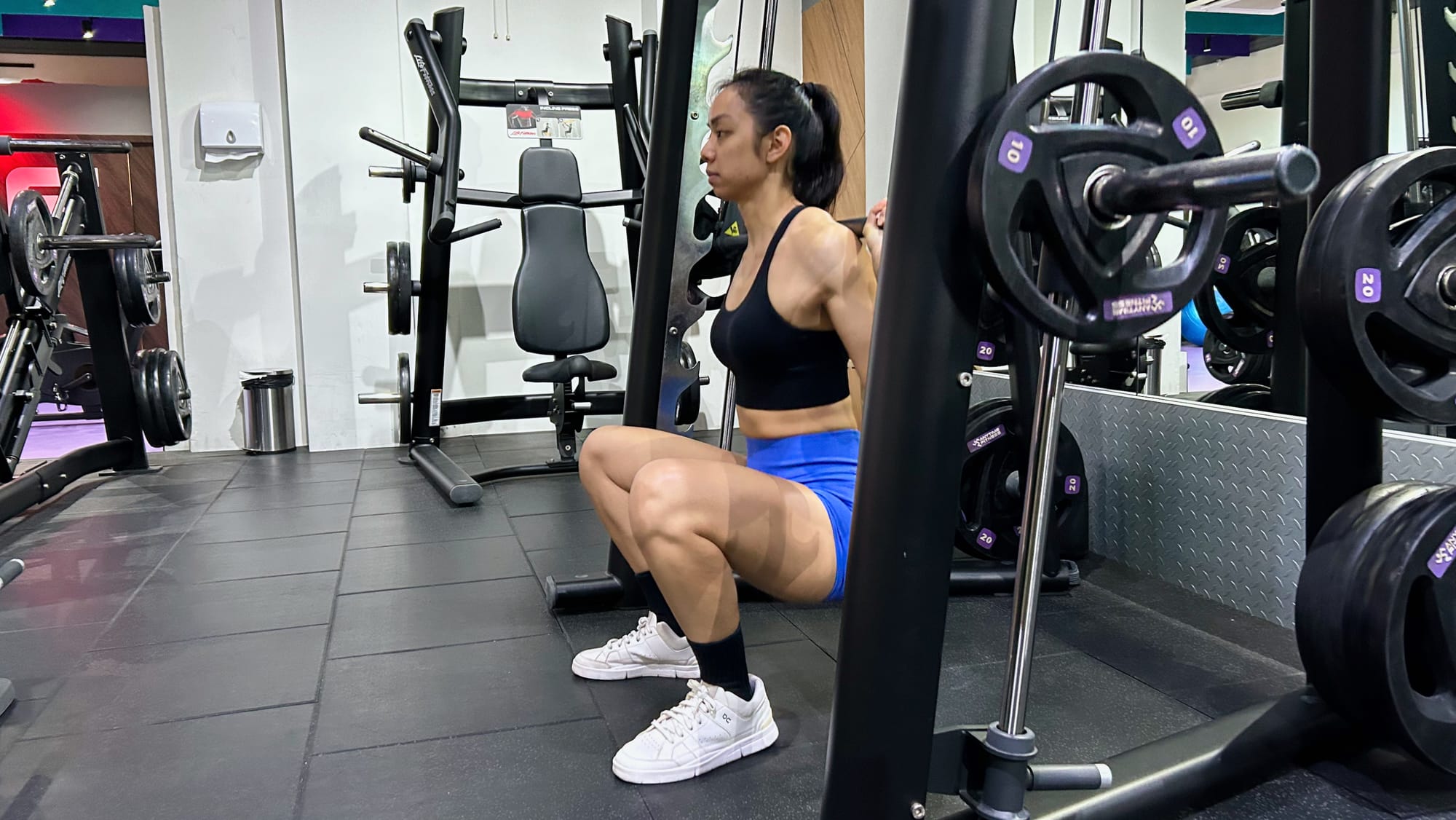
Unlike the barbell squat (with your feet directly under the bar), the Smith machine squat has a fixed movement path.
To squat efficiently using this path, you would need to lean back slightly (which is why the feet have to go in front of the bar).
Note: this is only possible since you don’t have to worry about balance on a Smith machine.
By keeping your feet in front of the bar, you’re able to:
- Maximize your squat depth (ROM)
- Prevent your heels from lifting off during the squat
How far should you lean back? This depends on your anatomy, mobility, and the particular Smith machine you’re using. Experiment to find a distance that lets you squat with a strong and comfortable form.
Adjust your feet position based on your Smith machine
There are 2 main types of Smith machines: vertical and angled.
The vertical Smith machine is straightforward. You can face inwards or outwards — it doesn’t matter.
The angled Smith machines, however, are more versatile (and confusing). You can adjust the focus of your squats based on the direction you face on the machine.
2 ways to perform squats on angled Smith machines:
- Quad-focused squat: Face outwards (more knee flexion, less hip flexion, greater ROM)
- Glute-focused squat: Face inwards (more hip flexion, less knee flexion, smaller ROM)
Get the right direction on the angled Smith machine:
@laurensimpsonofficial#fyp #gymtok #smithmachine #gymhack #squat #fitness #smithmachinesquats ♬ Big Boy (SZA) - Sped Up Remix - viral audios & nightcore sped up
OK, we don’t want to add to the confusion. But just know that, for some sick reason, there are Smith machines angled the opposite way. If that’s the case, reverse your directions accordingly.
Check out the Smith machine squats (and many more exercises) in this guide:
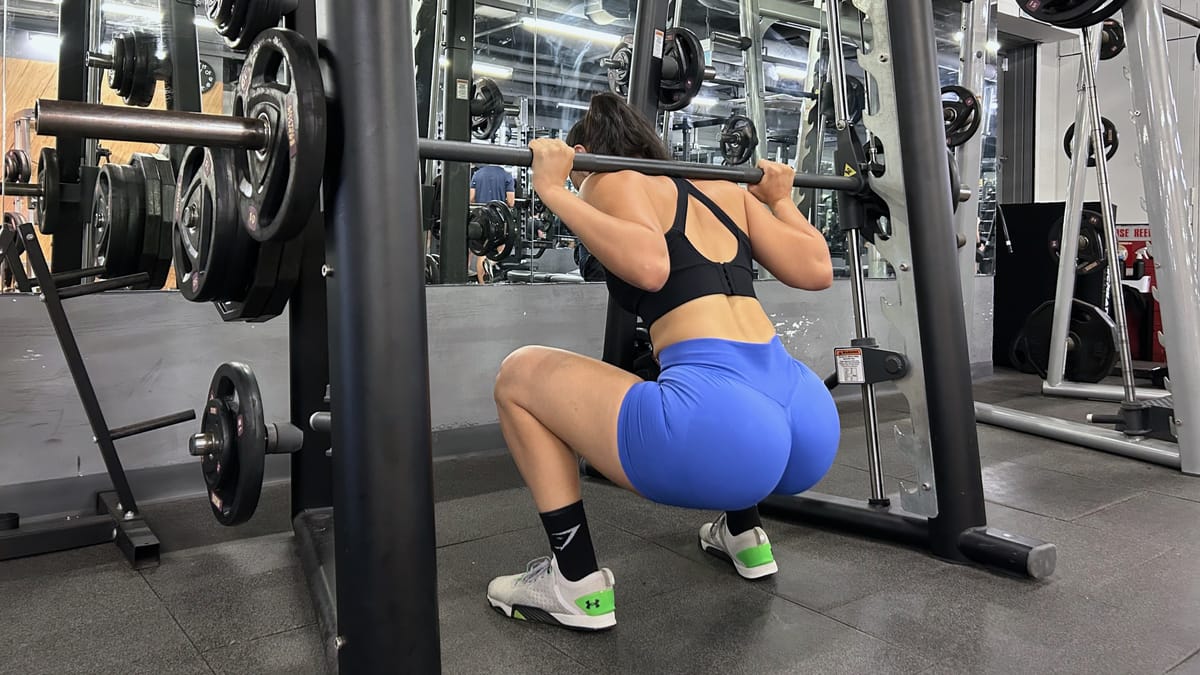
Both types of squat complement each other
This is a classic case of free weight vs machine.
While they’re both great for targeting the quads and glutes, the Smith machine squat doesn’t work the stabilizers as much as the barbell squat.
But this isn’t bad news at all.
In fact, this means you can use heavier loads on the Smith machine squat since you don’t have to work as hard to stay balanced.
The main takeaway:
- Barbell squat lets you work on your stabilizers
- Smith machine squat lets you use heavier loads
Both types of squats can complement each other and serve different purposes in your training.
While there’s nothing wrong with only choosing 1 to work with, it’s ideal to do both the Smith machine and barbell squats for better results.
How to choose?
Let’s just assume you’re sold on the idea of doing both the Smith machine and barbell squats.
Now, the important question is, “How much of each squat should you do?”.
Here are 3 main points to consider.
Think about your training goals
If your goal is building more muscle, just pick the squat variation you can progress better on. Make that the bulk of all the squats you do.
The Smith machine squat is likely the more popular pick here since it’s easier to overload and less limited by technique.
Example of weekly squat volume: 6 sets of Smith machine squats + 3 sets of barbell squats
If your goal is to compete in powerlifting (or if your sport requires it), focus on the barbell squat for specificity. Let the Smith machine squat be an accessory in your training.
Think about your weaknesses
If you need stronger stabilizers, include more barbell squats (and preferably, further supplement with unilateral exercises).
If your progress on barbell squats is slowing or has plateaued, try adding more Smith machine squats to improve the variety of stimulus you’re giving to your leg muscles.
Think about your preferences
If you don’t have a strong reason to favor one over the other, just go with the type of squat that you enjoy training with the most!
What’s most important here is consistency and progress. You should like an exercise enough to bring yourself close to failure on every single set.
FAQs about the Smith machine squat vs barbell squat
Let’s hope we read your mind and accurately predicted your questions here.
Are Smith machine squats more likely to cause injuries?
Let’s set your mind at ease — nope.
Despite how popular and long-running this theory is, there’s no published evidence suggesting that Smith machine squats are more likely to cause injuries than barbell squats.
What you want to do is approach the Smith machine squat like a new exercise.
Take the time to learn how to set it up and how to perform it correctly. Practice the movement and progress in weight gradually.
It’s not “just a barbell squat done on a Smith machine”.
Do Smith machine squats suck because they don't train stabilizers?
Sure, Smith machine squats don’t work the stabilizers as much as barbell squats.
But what if that’s the whole point?
💭What if your goal was to focus on overloading your muscles, rather than letting your stabilizers be the limiting factor?
That’s what Smith machine squats can do very well.
In short: think more about what an exercise can do for you, not what it cannot.
To drive home the point once more:
@sharellegrant#smithmschine #gymtok #gymgirl #musclebuilding ♬ original sound - Sharelle Grant | Fitness Coach
Is it worth learning the Smith machine squat?
Absolutely! It doesn’t have to be your mainstay squat variation, but it can be a useful tool in your arsenal.
It can serve as an alternative to your barbell squat, hack squat, or leg press.
And TBH, given how unloved Smith machines are, they’re a lifesaver in a crowded gym where just about everything is taken.
What can you even do on the Smith machine? Your options are so limited.
🥲 You might be right. We can only think of 20 Smith machine exercises worth trying.
We really need to come up with more options:






